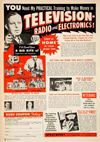If your trying to learn electrical systems for OPE (outdoor power equipment), motorcycle or car and truck service and repair, and your having trouble understanding a topic, sometimes it helps to read or hear the topic from another source. I've included links to lessons 1, 2, 3, and 6 found in a 1940's radio repair course by Sprayberry Academy of Radio. These lessons go over the fundamental concepts of electrical theory, which a service technician needs to know to understand how electrical systems on motorcycles, cars, trucks and OPE function and operate. I'm not saying these courses are a substitute for an electrical course in your field of study, but they might help you better understand a difficult topic. Whether your repairing old radios, televisions or fixing motorcycles, the fundamental concepts of electrical theory will be the same. This course was written before the transistor was invented, so it doesn't cover semi conductors or computers. These course files are in pdf format, so you need a pdf reader to view them.
 Click image to enlarge
Click image to enlarge- Lesson 1 - Introduction to Radio
- Lesson 2 - Basic Electricity
- Lesson 3 - Lines of Force
- Lesson 4 - Fundamentals of Transmission and Reception
- Lesson 5 - How to Read Radio Diagrams and Symbols
- Lesson 6 - Resistance: A Property of All Electric Circuits
- Lesson 7 - Coils in Radio Circuits
- Lesson 8 - Condensers in Radio Circuits
- Lesson 9 - Coils and Condensers in Combination - Resonance
- Lesson 10 - Radio Meters, Test Instruments
- Lesson 11 - Fundamentals of Radio Tubes - Rectifier Circuits
- Lesson 12 - Rectifier Tubes - Tube Standards and Ratings
- Lesson 13 - How A Radio Tube Makes A Weak Signal Stronger
- Lesson 14 - Vacuum Tube Amplification At High Frequencies
- Lesson 15 - Amplification at Low Frequencies
- Lesson 16 - Types of A.F. Amplifiers - Amplifier Classes
- Lesson 17 - How an RF Signal is Detected
- Lesson 18 - Speakers for Radio
- Lesson 19 - Power Transformers for Radio
- Lesson 20 - Choke Coils, Filter Systems and Voltage Dividers
- Lesson 21 - A Six Color Story of the Tuned Radio Frequency Receiver
- Lesson 22 - The Superheterodyne Receiver
- Lesson 23 - Superheterodyne Oscillator Tracking and Super Control Tubes
- Lesson 24 - Selectivity Factors of Tuned Circuits
- Lesson 25 - Automatic Volume or Sensitivity Controls
- Lesson 26 - Six Color Story of the Superheterodyne
- Lesson 27 - Improvements Which Simplify Receiver Operation and Decibels
- Lesson 28 - Multiple Band Receivers
- Lesson 29 - Microphones and Phonograph Pick-Up Units
- Lesson 30 - Transmission Lines, Pads and Attenuators
- Lesson 31 - Public Address or AF Sound Systems
- Lesson 32 - How Sound is Employed in the Movies
- Lesson 33 - How the Qualities of Sound Reproduction are Controlled
- Lesson 34 - Photo-Electronics
- Lesson 35 - Practical Applications of Photo-Electronics